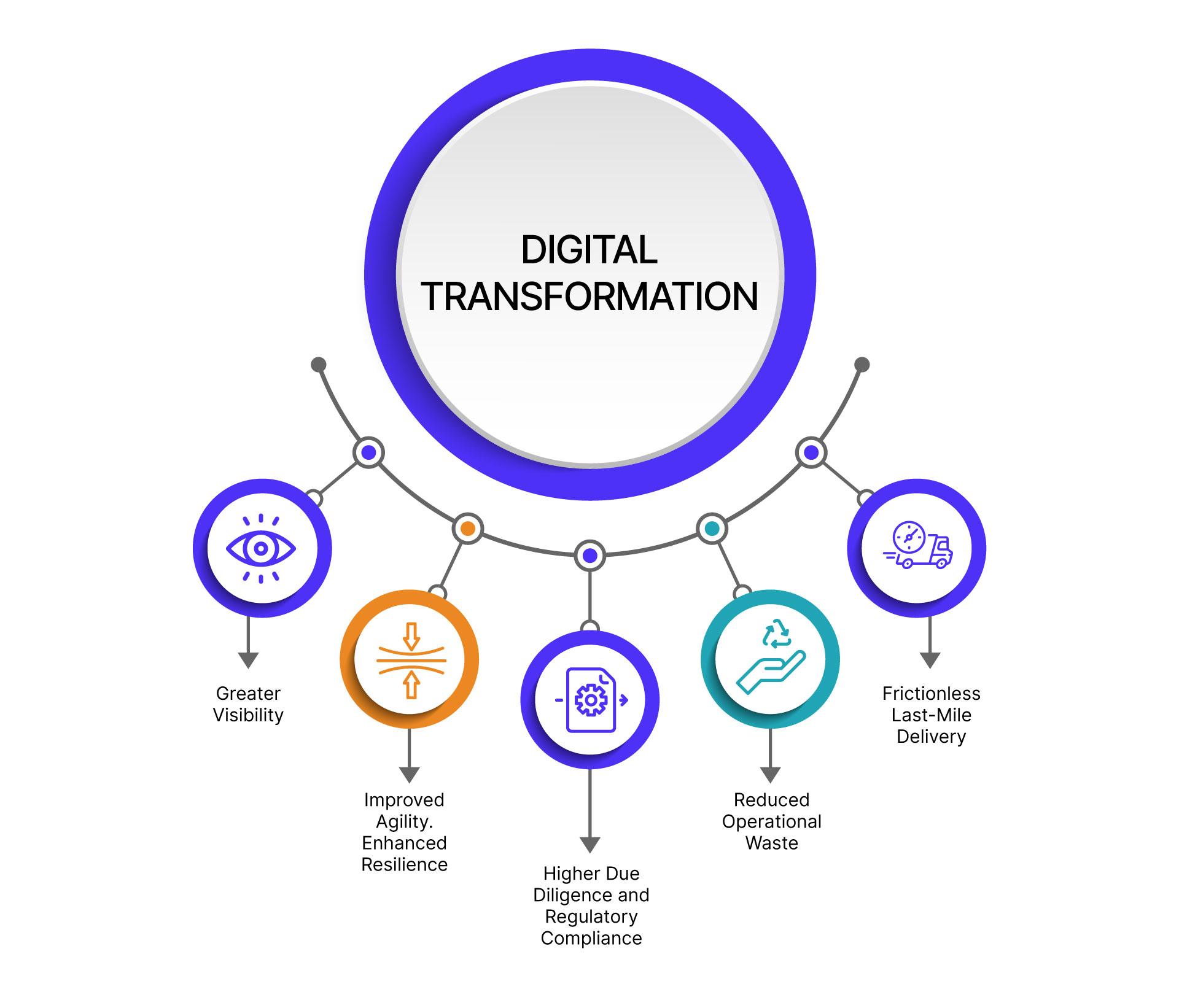The supply chain finds itself at a unique crossroads where contrarian forces pull it in different directions.
Firstly, it’s no longer a linear industry but a more complex, dynamic and interconnected one. On the one hand, you have factors like growth in cross-border e-commerce, encouraging trade policies, and positive reinforcement of feedback from SMEs globally that drive enormous growth in the supply chain. On the other hand, disruptive events like COVID-19, global chip shortage, inflationary pressures, the Russia-Ukraine conflict and US-China trade wars are destabilizers.
That’s why this sector is interested in digital transformation, not just because of its operational benefits but also because of its ability to enable the next wave of productivity.
So, in this blog post today, we will highlight the five ways digital transformation is empowering the supply chain and logistics industry.
Digital Transformation

Follow our newsletter for more insights.
Greater Visibility
A recent report states that only 6% of businesses claim to have complete supply chain visibility.
Lack of visibility impairs your ability to track assets and data. Inadequate clarity limits your ability to come up with well-informed and effective decisions. This results in units within the supply chain cycle working as disjointed fragments. Consequently, this will erode your customers’ trust in the supply chain’s capabilities as a dependable planning resource.
With integrated digital solutions and holistic platforms that provide end-to-end forward-looking visibility of your supply chain cycle, you are better informed about the real-time movement of goods, data and people. IoT sensors and RFID technology enable the tracking goods at every stage, reducing the risk of delays and errors. Advanced analytics and AI algorithms analyze vast datasets, offering insights into demand patterns and inventory levels. Cloud-based platforms facilitate seamless collaboration among stakeholders, enhancing transparency.
Improved Agility. Enhanced Resilience
One of the unintended consequences of an interconnected supply chain ecosystem is its vulnerability to external events. And with the world becoming more unpredictable, disruption is the new normal that industries and organizations must adapt to. And only a few of us have notably developed our resilience capabilities.
Digital transformation helps supply chain providers with the permeability of information and data. Data permeability strengthens supply chain agility and resilience by enabling real-time information flow. Seamless data accessibility allows swift adjustments to production, inventory and distribution, enhancing responsiveness to market shifts.
Predictive analytics aids in identifying and mitigating risks proactively. It also helps optimize resource allocation and provide more agile responses to disruptions, strengthening this sector’s resilience to the new normal.
Reduced Operational Waste
Digital transformation reduces operational waste and enhances cost savings in the supply chain. Robotics and Automation streamline processes, reduce manual efforts on repetitive processes, minimize errors and optimize resource allocation. Cloud is a more cost-effective replacement of in-house IT infrastructure, offering scalability and efficiency and reducing maintenance liabilities. Emerging technologies like Blockchain ensure transparent and tamper-proof transactions, reducing fraud and enhancing trust.
Frictionless Last-Mile Delivery
The last-mile delivery market in India is all set to reach $6 bn by 2024 and with a CAGR of 15.62%, it’s estimated to become $165.62 bn by 2027. With digital stalwarts like Amazon and Uber taking the lead, this has opened up newer revenue streams for an otherwise low-profit margin industry. However, executing speedy, successful, and seamless last-mile deliveries requires logistics and supply chain providers to attain a level of digital maturity beyond implementing isolated digital tools to rejigging organizational structural and cultural changes.
Implementing customized SaaS solutions with predictive analytics and leveraging emerging technologies like autonomous drones and vehicles, edge computing and AI-ML are all components of driving a successful digital transformation strategy to enable smooth last-mile deliveries.
However, it starts with solid buy-in from major stakeholders and addressing roadblocks to change strategically. Last-mile deliveries are fast, and their landscape remains dynamic because of the heightened agility displayed by the digital native entrants in embracing and leveraging emerging technologies for improved outcomes. Hence, the need to digitize faster and fuller.
Comprehensive Record Keeping for Due Diligence and Regulatory Compliance
In an era of Blockchain and Automation, 67% of organizations still use Excel sheets to plan, track and manage supply chain activities. Such an approach slows operational agility and makes it a breeding ground for errors, data manipulation and inconsistencies in due diligence and compliance monitoring.
Digital record-keeping in the supply chain helps providers become more organized with their record management and ensures due diligence and regulatory compliance through transparency, consistency and accuracy.
While financial due diligence focuses on an organization’s revenue streams, operational due diligence aims to evaluate processes, systems and IT infrastructure. Legal due diligence monitors a supply chain provider’s labor laws, regulatory compliance and insurance coverage. With every major economy rolling out stringent checks on supply chain due diligence, it makes better business sense to leverage digital technologies for more holistic and scalable record management solutions.
Comprehensive documentation, facilitated by technologies like IoT and Blockchain, offers real-time tracking and a robust audit trail for all types of due diligence checks. The quick retrieval of information stored centrally expedites compliance evaluations, while automated systems reduce human errors and expedite operational efficiency by automating repeatable and redundant processes.
Reducing operational costs while improving efficiency is an ongoing endeavor for any industry. But digital transformation goes many steps beyond. It builds an environment that fosters innovation, introduces efficiencies, enhances customer satisfaction and contributes to a sustainable future. This holistic impact prepares organizations for long-term viability and resilience in the evolving growth, disruption and uncertainty landscape.